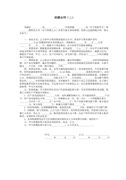大学英语六级口试自我介绍
【简介】感谢网友“ceot”参与投稿,下面小编为大家整理了大学英语六级口试自我介绍(共4篇),欢迎阅读与借鉴!
篇1:大学英语六级考试口试文章练习
Prices determine how resources are to be used. They are also the means by which products and services that are in limited supply are rationed among buyers. The price system of the United States is a complex network composed of the prices of all the products bought and sold in the economy as well as those of a myriad of services, including labor, professional, transportation, and public-utility services. The interrelationships of all these prices make up the “system” of prices. The price of any particular product or service is linked to a broad, complicated system of prices in which everything seems to depend more or less upon everything else.
If one were to ask a group of randomly selected individuals to define “price”, many would reply that price is an amount of money paid by the buyer to the seller of a product or service or, in other words that price is the money values of a product or service as agreed upon in a market transaction. This definition is, of course, valid as far as it goes. For a complete understanding of a price in any particular transaction, much more than the amount of money involved must be known. Both the buyer and the seller should be familiar with not only the money amount, but with the amount and quality of the product or service to be exchanged, the time and place at which the exchange will take place and payment will be made, the form of money to be used, the credit terms and discounts that apply to the transaction, guarantees on the product or service, delivery terms, return privileges, and other factors. In other words, both buyer and seller should be fully aware of all the factors that comprise the total “package” being exchanged for the asked-for amount of money in order that they may evaluate a given price.
篇2:大学英语六级考试口试文章练习
A painter hangs his or her finished pictures on a wall, and everyone can see it. A composer writes a work, but no one can hear it until it is performed. Professional singers and players have great responsibilities, for the composer is utterly dependent on them. A student of music needs as long and as arduous a training to become a performer as a medical student needs to become a doctor. Most training is concerned with technique, for musicians have to have the muscular proficiency of an athlete or a ballet dancer. Singers practice breathing every day, as their vocal chords would be inadequate without controlled muscular support. String players practice moving the fingers of the left hand up and down, while drawing the bow to and fro with the right arm―two entirely different movements.
Singers and instruments have to be able to get every note perfectly in tune. Pianists are spared this particular anxiety, for the notes are already there, waiting for them, and it is the piano tuner’s responsibility to tune the instrument for them. But they have their own difficulties; the hammers that hit the string have to be coaxed not to sound like percussion, and each overlapping tone has to sound clear.
This problem of getting clear texture is one that confronts student conductors: they have to learn to know every note of the music and how it should sound, and they have to aim at controlling these sound with fanatical but selfless authority.
Technique is of no use unless it is combined with musical knowledge and understanding. Great artists are those who are so thoroughly at home in the language of music that they can enjoy performing works written in any century.
篇3:大学英语六级考试报考指南:口试大纲
口试大纲
口语考试成绩合格者由教育部高等教育司发给证书,证书分为 A、B 、C 三个等级,成绩低于 C 等的不发给证书
大学英语四、六级考试口语考试能力等级标准如下:
等级
等 级 描 述
A 等
能用英语就熟悉的题材进行口头交际,基本上没有困难
B 等
能用英语就熟悉的题材进行口头交际,虽有些困难,但不影响交际
C 等
能用英语就熟悉的题材进行简单的口头交际
D 等
尚不具有英语口头交际能力
一、评分标准
CET-SET 主考在评分时使用以下标准:
a. 准确性 指考生的语音、语调以及所使用的语法和词汇的准确程度
b. 语言范围 指考生使用的词汇和语法结构的复杂程度和范围
c. 话语的长短 指考生对整个考试中的交际所作的贡献、讲话的多少
d. 连贯性 指考生有能力进行较长时间的、语言连贯的发言
e. 灵活性 指考生应付不同情景和话题的能力
f. 适切性 指考生根据不同场合选用适当确切的语言的能力
二、语言功能
CET-SET 考试要求考生参与不同形式的口头交际,其语言能力将根据其在考试中的表现予以测量,考生需要掌握的语言功能和意念在《大学英语教学大纲》中已明确列出。以下仅列举其中部分的语言功能和意念。
友好往来
问候,介绍,告别和告辞,祝愿和祝贺,感谢和应答,道歉和应答,提议、邀请和应答。
相互交流
开始交谈,继续交谈,改变话题,停止交谈。
态度
愿意,希望,意向,决心,责任,能力,允许,禁止,同意和不同意, 否定,喜欢和不喜欢,偏爱,责怪和抱怨,判断、决定和意见。
劝说
命令,劝告和建议,承诺,提醒。
感情
焦虑,惊奇,兴趣,加重感情色彩。
存在
存在和不存在,有和没有。
空间描述
位置,方向,运动,距离。
时间
时刻,时段,时间关系,频度,时序。
发表意见和看法
询问意见和看法,发表意见和看法,对意见和看法的反应,同意,不同意,要求澄清,澄清意见和看法。
争辩
讨论,讨论观点,反驳论点,提出进一步论证,劝说和对劝说的反应。
三、考试形式
CET-SET 考试分三部分:
第一部分是考生和 CET 授权的主考进行交谈,采用问答的形式。时间约 5 分钟。
第二部分包括 1.5 分钟的考生个人发言和 4.5 分钟的小组讨论。时间共约 10 分钟。
第三部分由主考再次提问以进一步确定考生的口头交际能力。时间约 5 分钟。
四、输入信息
CET-SET 考试运用以下两种形式的输入信息来产生信息差:
1)画面提示(如图片、图表、照片等);
2)文字提示。
五、标准描述
语言准确性和范围
话语的长短和连贯性
语言灵活性和适切性
5 分
语法和词汇基本正确
表达过程中词汇丰富、语法结构较为复杂
发音较好,但允许有一些不影响理解的母语口音
在讨论有关话题时能进行较长时间的、语言连贯的发言,但允许由于无法找到合适的词语而造成的偶尔停顿
能够自然、积极地参与讨论
语言的使用总体上能与语境 、功能和目的相适应
4 分
语法和词汇有一些错误,但未严重影响交际
表达过程中词汇较丰富
发音尚可
能进行较连贯的发言,但多数发言较简短
组织思想和搜寻词语时频繁出现停顿,有时会影响交际
能够较积极地参与讨论,但有时内容不切题或未能与小组成员直接交流
语言的使用基本上能与语境、功能和目的相适应
3 分
语法和词汇有错误,且有时会影响交际
表达过程中词汇不丰富,语法结构较简单
发音有缺陷,有时会影响交际
发言简短
组织思想和搜寻词语时频繁出现较长时间的停顿,影响交际,但能够基本完成交际任务
不能积极参与讨论,有时无法适应新话题或讨论内容的改变
2 分
语法和词汇有较多错误,以致妨碍理解
表达过程中因缺乏词汇和语法结构而影响交际
发音较差,以致交际时常中断
发言简短且毫无连贯性,几乎无法进行交际
不能参与小组讨论
六、考生手册
A. 考试简介
1 考试性质
大学英语四、六级考试口语考试( CET Spoken English Test ,简称 CET-SET )用于测量我国大学生运用英语进行口头交际的能力
2 考试对象
CET-SET 报考对象为获得全国大学英语四、六级证书且成绩达到一定分数线的在校大学生,
试行阶段的报考对象根据教育部有关文件决定,具体报名规定见考试委员会通知。
3 考试形式
CET-SET 考试采用面对面的形式,每场考试由 2 名主考和 3 (或 4 )名考生组成(如下图):
4 试题构成
部 分
时间
题型
说 明
Part 1
5 分钟
问答
“热身”题,包括考生自我介绍、回答问题。
Part 2
10 分钟
发言和讨论
考生准备 1 分钟后,根据所给提示作一个 1.5 分钟的发言;小组就指定的话题讨论(约 4.5 分钟)。
Part 3
5 分钟
问答
由主考进一步提问。
5 考试成绩
考试总分为 15 分,分为 A 、B 、C 和 D 四个等级(描述见“能力等级标准”)。
6 合格证书
C 等以上者将获得由教育部高教司颁发的注有 CET Spoken English Test 成绩等级的 CET 证书。
B. 考生须知
1 报名条件及流程:
教育部规定四级笔试550分、六级520分以上的考生可以报名参加口试.
全国大学英语四、六级考试委员会根据教育部主管部门的文件规定,在有关城市设立若干个考点。考生到所在考试中心指定的考点报名并参加考试,报名时须随身携带身份证、二寸报名照一张及报名费用。
报名流程:
2 注意事项
・ 考生须携带本人的准考证和身份证准时到规定的候考室报到,逾时 15 分钟不得进考场。
・ 考生如发现准考证上的姓名有误,请在正式开考前将修改后的准考证交给主考,由主考按身份证上的姓名核对并签名确认。
・ 如中途无故退场,将作自动放弃考试处理,成绩一律记为不合格。
・ 自备饮料;不得携带手机、拷机等通讯工具进入候考室。
・ 考生须在候考室等候参加考试,在候考期间未经同意不得随意离开候考室。
・ 考试期间,必须遵守考场纪律,服从管理人员安排。
・ 考试结束时,必须将准考证交给主考,同时记下自己的准考证号。
・ 考试结束后,必须立即离开考区。
3 考试时间
一年两次,分别在 5 月和 11 月。
4 考试地点
考试地点在考生报名的考点。具体考场在考生报到后随机编组确定。
5 考生培训
考生必须参加考点组织的考前培训,包括:
・ 通知考试时间、地点、考场及候考室等考务安排
・ 介绍大学英语四、六级考试口语考试程序并播放考试过程录像
C. 能力等级标准
等级
等 级 描 述
A+
14.5-15分
A
13.5-14.4分
能用英语就熟悉的题材进行口头交际,基本上没有困难。
B+
12.5-13.4 分
B
11-12.4 分
能用英语就熟悉的题材进行口头交际,虽有些困难,但不影响交际。
C+
9.5-10.9 分
C
8-9.4 分
能用英语就熟悉的题材进行简单的口头交际。
D
7.9 分以下
尚不具有英语口头交际能力。
篇4:大学生面试口试自我介绍
,
并在实践中,加深了对××的熟悉,进步了软件设计(或其他技术)的实际操纵能力。
另外,在学校中也参加过一些社团活动,比如××(此处最好说1-2样),在其中加强了和同学们的团队协作,并且有×××的感受和知识。
个性上××××(此处copy简历里面的性格介绍,主要要有团队精神,个人踏实努力,有责任感之类的)
在这里应聘贵公司的××职位,是想将自己的所学得到充分发挥,并在这里学习成长。希看有这样的机会,能和诸位成为同事。
我的情况大概就是这样,请问您有什么其他方面想要了解的么?(主体说完之后来句这个,可以直接话题过度给口试的人,省得最后冷场)












